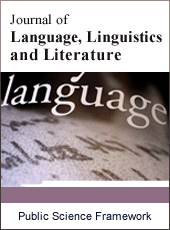Journal of Language, Linguistics and Literature
Articles Information
Journal of Language, Linguistics and Literature, Vol.1, No.3, Jun. 2015, Pub. Date: Jun. 8, 2015
Literary Portrait as a Part of Publicistic Cycle
Pages: 94-100 Views: 3675 Downloads: 1097
[01]
Baglan Bazylova, Head of the Department, Kazakh State Women's Teacher Training University, Almaty, Kazakhstan.
[02]
Zhanna Zhussupova, Head of the Department, K. Zhubanov Aktobe Regional State University, Aktobe, Kazakhstan.
In the Russian prose of the XIX century the genre of a literary portrait was considered as characteristic of a specific person presented in the form of memoirs. The image of the hero defines purpose, choice of means and composition of a literary portrait. The supervision and impressions imprinted in the author's memory serve as material for careful selection of details which recreate contemporaries’ images. The literary portrait of Tolstoy "The great pilgrim" was published in 1922. The article considers memoir sketch "The great pilgrim" in the context of journalism of Korolenko who possesses expressed signs of literary portrait genre. Its structure represents a complete art ensemble motivated with special type of a subject situation. It is a situation of direct communication where impression of the memoirist reveals. Korolenko's meetings with Tolstoy depicted in the introduction to "The great pilgrim" couldn't be "organically introduced" in this structure. In art "incompleteness" of memoirs received an embodiment Korolenko's thought of continuous search of truth by Tolstoy artist and thinker. The subsequent creativity of Tolstoy confirmed justice of supervision and art conclusions of the memoirist.
Literary Portrait, Structure of Work, Image of the Hero, Publicistic Reception
[01]
Bialy, G.A. (1949). Korolenko V.G., Moscow.
[02]
Bolshakov, A. (2003). Modern theories of the genre in the Anglo-American literary criticism. // Theory of literature. V. 3. Births and genres (the main problems in historical interpretation), Moscow.
[03]
Births and genres (the main problems in historical interpretation), Moscow.
[04]
Khrapchenko, M.B. (1969). Typological study of literature and its principles //Problems of typology of Russian realism, Moscow.
[05]
Korolenko, S. (1968). Book about his father, Izhevsk.
[06]
Korolenko, V.G. (1955). Works: 10 V, Moscow, V. 8.
[07]
Korolenko, V.G. (1974). Works: 5 V. Moscow, V. 2.
[08]
Lotman, Y. (1969). On the typological study of literature // Problems typology of Russian realism, Moscow.
[09]
Repin, I. (1967). Distant close, Moscow.
[10]
Rostov, N. V. (1965). Korolenko, Moscow.
[11]
Rothenberg, E. (1971). Western European art VII century, Moscow.
[12]
Timofeev, L.I. (1955). Form of fiction / / Problems of theory literature, Moscow.
[13]
Tolstoy, L.T. (1987). Complete Works. Moscow, V. 12.
[14]
Tamarchenko, N.D. (2004). "Solid" and "free" versions of the epic form // Literary theory, Moscow.

ISSN Print: 2381-7054
ISSN Online: 2381-7062
Current Issue:
Vol. 6, Issue 1, March Submit a Manuscript Join Editorial Board Join Reviewer Team
ISSN Online: 2381-7062
Current Issue:
Vol. 6, Issue 1, March Submit a Manuscript Join Editorial Board Join Reviewer Team
| About This Journal |
| All Issues |
| Open Access |
| Indexing |
| Payment Information |
| Author Guidelines |
| Review Process |
| Publication Ethics |
| Editorial Board |
| Peer Reviewers |


